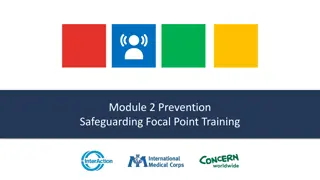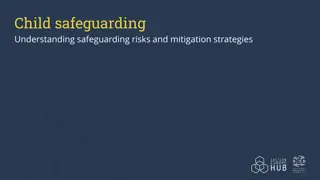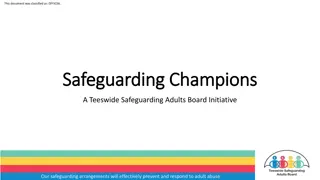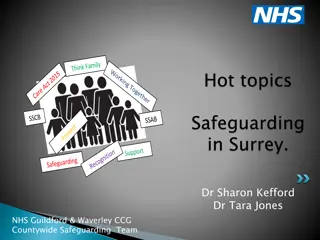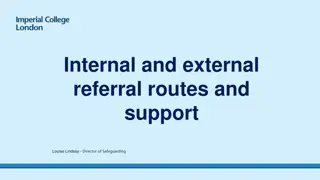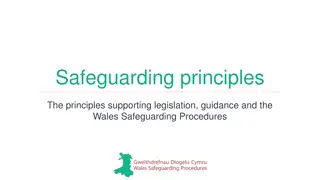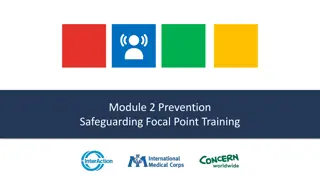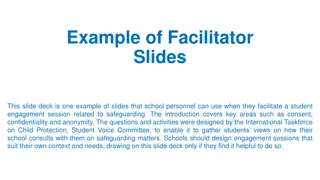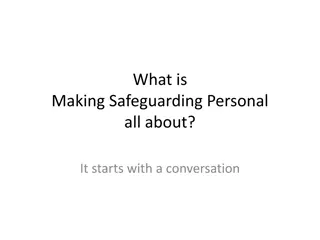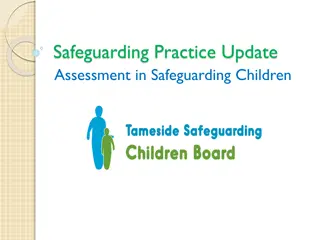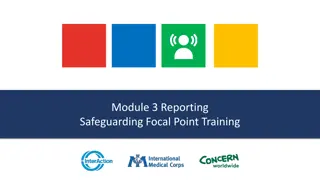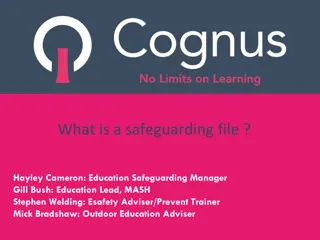Safeguarding for Community Volunteers
Safeguarding is crucial for community volunteers to protect both children and adults from harm such as abuse and neglect. Recognizing signs, taking appropriate measures, and having a designated safety lead are important aspects of volunteering safely. Following simple precautions and reporting any concerns are key in safeguarding efforts.
Download Presentation

Please find below an Image/Link to download the presentation.
The content on the website is provided AS IS for your information and personal use only. It may not be sold, licensed, or shared on other websites without obtaining consent from the author.If you encounter any issues during the download, it is possible that the publisher has removed the file from their server.
You are allowed to download the files provided on this website for personal or commercial use, subject to the condition that they are used lawfully. All files are the property of their respective owners.
The content on the website is provided AS IS for your information and personal use only. It may not be sold, licensed, or shared on other websites without obtaining consent from the author.
E N D
Presentation Transcript
Safeguarding for community volunteers
What is safeguarding? Safeguarding is the measures and steps we all take when we are concerned that someone a child or an adult is/is likely to be risk of suffering significant harm. This includes physical, psychological/ emotional, financial, sexual abuse and grooming and neglect. It s important to be able to recognise the signs so that you or your volunteers can stay safe, and know how to alert the relevant authorities who can then take action to make sure people are safe in your community. www.safeguardingcambspeterborough.org.uk
Safeguarding and DBS We know that many people will want to volunteer to support their local communities, either individually or as part of an organised group. There are many ways to help, but it is important it is done safely for all involved. Many of the roles that volunteers will carry out in their local communities do not raise safeguarding issues and do not need a DBS check. The Government DBS eligibility guidance will confirm whether the activities your group propose to do require a DBS. If you are providing care or to help a vulnerable person, you should still be following social distancing rules where possible. www.safeguardingcambspeterborough.org.uk
Safeguarding and DBS As part of volunteering, you may see something that concerns you about the welfare or safety of someone in your community. It is important that we put the structures in place to keep each other safe during this period. The Government recommends that someone amongst your group takes the lead for keeping you and the people you seek to support safe. This role is so important to ensuring the informal activity taking place is done in a way that doesn t make the problem worse, or cause more risks for those involved. www.safeguardingcambspeterborough.org.uk
Regardless of the activities being undertaken, you should ensure your group follows simple, practical precautions such as: working safely in pairs keeping records of money spent providing shopping receipts This helps to safeguard all involved. www.safeguardingcambspeterborough.org.uk
What to do ? Follow the principles of : Stay safe See it Recognise it Report it Possible signs and symptoms which can indicate harm or abuse are many and varied, and recognising these is an important part of keeping safe in volunteering. www.safeguardingcambspeterborough.org.uk
There are Four Types of Child Abuse Physical Emotional Sexual Neglect www.safeguardingcambspeterborough.org.uk
Physical abuse may involve hitting, shaking, throwing, poisoning, burning or scalding, drowning, suffocating, or otherwise causing physical harm to a child. Physical harm may also be caused when a parent or carer fabricates the symptoms of, or deliberately induces illness in a child. (Source- Working Together to Safeguard Children, 2018)
Common sites for accidental injury Forehea d Nose NB this does not include pre- mobile babies Chin Shoulders Bony spine Elbows Hips Forearms Knees Shins
Sites of possible non-accidental injury Head injuries (fractures) Bruised eyes Ears (bruises, tears) Mouth (bruises, tears) Bruises, grasp marks on arms, shoulders and neck Chest bruised with grasp marks or by implements Cigarette burns Twisting fractures Abdomen Buttocks (Bruising or scalds) Thighs (Bruising or scalds)
Sexual Abuse - Sexual abuse involves forcing or enticing a child or young person to take part in sexual activities, not necessarily involving a high level of violence, whether or not the child is aware what is happening. The activities may involve physical contact, including assault by penetration (e.g. rape or oral sex)or non-penetrative acts such as masturbation, kissing, rubbing or touching outside of the clothing. They may include non-contact activities, such as involving children in looking at, or in the production of, sexual images, watching sexual activities, encouraging children to behave in sexually inappropriate ways, or grooming a child in preparation for abuse (including via the internet). Sexual abuse is not solely perpetrated by adult males. Women can also commit acts of sexual abuse, as can other children.
Emotional Abuse Persistent emotional maltreatment of a child such as to cause severe and adverse effects on the child s emotional development. Cant you do anything right? I wish you were dead I wish you had never been born Worthless!
Babies & Young Children may Older Children May Be wary or Anxious Struggle to control emotions Be overly-affectionate Lack social skills/ friends Not show signs of attachment to parents Seem Isolated from parents Be aggressive or nasty to other children or animals Use language/act/ know about things you wouldn t expect for their age
Neglect Neglect is the persistent failure to meet a child s basic physical and/or psychological needs, likely to result in the serious impairment of the child s health or development. Neglect may occur in pregnancy as a result of maternal substance misuse.
How to deal with a disclosure
If a child discloses abuse If you're in a situation where a child discloses abuse to you, there are a number of steps you can take. Listen carefully to the child. Avoid expressing your own views on the matter. A reaction of shock or disbelief could cause the child to 'shut down', retract or stop talking Let them know they've done the right thing. Reassurance can make a big impact to the child who may have been keeping the abuse secret
If a child discloses abuse Tell them it's not their fault. Abuse is never the child's fault and they need to know this Say you believe them. A child could keep abuse secret in fear they won't be believed. They've told you because they want help and trust you'll be the person to believe them and help them
Don't promise to keep a secret Explain what you'll do next Don't delay reporting the abuse
https://learning. nspcc.org.uk/m edia/1638/let- children-know- listening-poster- english.pdf
WHAT TO DO IF YOU ARE CONCERNED ABOUT A CHILD: Discuss with someone senior who is helping run the community work/ the safeguarding lead Decide what action is to be taken is the child suffering or likely to suffer significant harm or is he/she in need of Early Help?
Early Help Most children and young people do not need Children s Social Care intervention, they can be helped through Early Help earlyhelp@peterborough.gov.uk early.helphub@cambridgeshire.gov.uk www.safeguardingcambspeterborough.org.uk
If you do need to refer childrens social care Report a Safeguarding Concern Cambridgeshire Peterborough Safeguarding Partnership Board - Internet Explorer
Reporting Child Protection Concerns to the Local Authority If you are concerned that a child may be suffering physical, sexual or emotional abuse or neglect or is at risk of significant harm you should telephone Children Services using one of the following numbers: Cambridgeshire children: 0345 045 5203 Peterborough children: 01733 864180 or Out of Hours Emergency Duty Team (EDT): 01733 234724 As a professional you can report a safeguarding concern using the Cambridgeshire & Peterborough Safeguarding Referral Form. Email to: ReferralCentre.Children@cambridgeshire.gov.uk All telephone referrals will need to be followed up in writing within 24 hours by the referring professional www.safeguardingcambspeterborough.org.uk
Making a Child Protection Referral Include as much information as possible. The quality of a referral significantly impacts on how effectively Children Social Care is able to respond to safeguarding. With poor information, Children Social Care is unable to make appropriate and proportionate decisions. This can put a child or young person at risk OR lead to overly intrusive interventions which are disruptive to the child and/or family www.safeguardingcambspeterborough.org.uk
Children worried about Coronavirus The NSPCC has created a new webpage with information and advice for parents or carers who are worried a child or young person may be struggling with their mental health or has anxiety about Coronavirus. The webpage includes information on: talking about feelings and worries; keeping in touch and balancing screen time; ways to create structure and routine; and helping to give children a sense of control. https://www.childline.org.uk/info-advice/your-feelings/anxiety- stress-panic/worries-about-the-world/coronavirus/ www.safeguardingcambspeterborough.org.uk
Domestic Violence and self isolation Government s advice on self or household-isolation will have a direct impact on victims of domestic abuse. Home is not likely to be a safe place for survivors of domestic abuse and their children. Social distancing and self-isolation could be used as a tool of coercive and controlling behaviour by perpetrators, and will shut down routes to safety and support. The National Domestic Abuse Helpline continues to operate 24/7 on 0808 2000 247 www.safeguardingcambspeterborough.org.uk
Domestic Violence and self isolation There is also a form you can complete online and they will call you back at a safe time https://www.nationaldahelpline.org.uk/Contact-us Women's Aid online chat is still open https://chat.womensaid.org.uk/ And Men's Advice line, for male victims, is still open too https://mensadviceline.org.uk/ www.safeguardingcambspeterborough.org.uk
Domestic Violence and self isolation Locally, Outreach Services are still available too: Cambridge City/East Cambs/South Cambs 01223 361214 Fenland/Hunts/Peterborough 07787 255821 For support around sexual violence, local Rape Crisis Helplines are closed but National Rape Crisis is still available and they also have online chat https://rapecrisis.org.uk/ And The Elms Sexual Assault Referral Centre is still open https://www.theelmssarc.org/ www.safeguardingcambspeterborough.org.uk
Safeguarding means protecting an adults right to live in safety, free from abuse and neglect. It is about people and organisations working together to prevent and stop both the risks and experience of abuse or neglect, While at the same time making sure that the adult s wellbeing is promoted including, where appropriate, having regard to their views, wishes, feelings and beliefs in deciding on any action. Care and Support Statutory Guidance, available at: https://www.gov.uk/government/publications/care-act-statutory-guidance/care-and- support-statutory-guidance www.safeguardingcambspeterborough.org.uk
MSP Making safeguarding personal- making sure that the adult s wishes, thoughts and feelings are taken into account when considering how to reduce risk or stop abuse from happening. www.safeguardingcambspeterborough.org.uk
Who is an Adult with Safeguarding Needs? Also called An adult at risk Previously called a vulnerable adult www.safeguardingcambspeterborough.org.uk
An Adult with Safeguarding Needs: 1.Has care and support needs 2.Is experiencing or at risk of abuse or neglect 3. As a result of those care and support needs, is unable to protect themselves from the risk or experience of abuse or neglect. www.safeguardingcambspeterborough.org.uk
Care and Support Needs a physical disability, a learning disability or a sensory impairment mental health needs, including dementia or a personality disorder long-term health condition substances or alcohol misuse to the extent that it affects ability to manage day-to-day living. www.safeguardingcambspeterborough.org.uk
There are 10 Types of Adult Abuse Neglect/ Acts of Omission Physical Sexual Psychological Financial/ Material Domestic Organisational Discriminatory Modern Slavery Self Neglect www.safeguardingcambspeterborough.org.uk
10 Types of abuse For descriptions of each type of abuse, see: Cambridgeshire and Peterborough Multi Agency Safeguarding Procedures, section 1.4, http://www.safeguardingcambspeterborough.org.uk/wp- content/uploads/2018/11/CPSAB-Multi-agency-Safeguarding- Adults-Procedures.pdf#page=7, SCIE: https://www.scie.org.uk/safeguarding/adults/introduction/types- and-indicators-of-abuse
Shielding, Social Distancing and Increased Risk Whilst Social Distancing measures are necessary to contain the spread of Covid-19, the same measures may increase risks for adults at risk of abuse. Home is not likely to be a safe place for adults who are abused by a family carer. Social distancing and self-isolation could be used as a tool of coercive and controlling behaviour by perpetrators, and will shut down routes to safety and support.
Support for Carers Pressure on family carers is likely to increase, with stay at home policies and scarcity in resources designed to support carers. Caring together is offering phone based and online support for carers in the meantime: https://www.caringtogether.org/coronavirus-covid- 19
Indicators These are the things that you might see, hear, smell or feel that would make you wonder if someone is being abused or neglected This includes things like bruises and marks of physical abuse, as well as changes in demeanour, activity, weight, appearance/presentation
If you spot indicators of abuse, what do you do? Ask. Make sure it is safe to do so Be genuine Be specific www.safeguardingcambspeterborough.org.uk
If someone tell you about abuse Listen Acknowledge Find out what they want to have happen next Explain that you need to tell someone
Remember that the adult has special insight into their own situation. www.safeguardingcambspeterborough.org.uk
Go at their pace Remember, The adult may need time to process They may have different priorities They may not want help They may not want help right now It can take time to establish trust
If someone discloses abuse: Do not press the person for more details Do not stop someone who is freely recalling significant events Do not dismiss what you have been told Do not promise to keep secrets; but do explain that the information will only be passed to those who "need to know", and try to be specific about who these might be Do not tell anybody who doesn't need to know remember the rules of confidentiality Do not make promises that you cannot keep Do not contact the alleged abuser or anyone who might be in touch with him / her Do not ask leading questions www.safeguardingcambspeterborough.org.uk
Other sources of Support Sometimes adults don t want a safeguarding concern raised, but are willing to accept help from other sources. (Including you, their GP, the community, etc.) www.safeguardingcambspeterborough.org.uk
Record What the adult at risk has told you (using their own words where possible) Who was involved The impact of the abuse on the adult What steps have been taken to protect the adult Name and signature of the person making the record www.safeguardingcambspeterborough.org.uk
Who is your Adult Safeguarding Lead? You should discuss any concerns you have about an adult with your volunteer coordinator. They should support you to: Talk to the adult you are concerned about Record what you know Plan how to support the adult Raise a safeguarding concern with the Local Authority if appropriate


